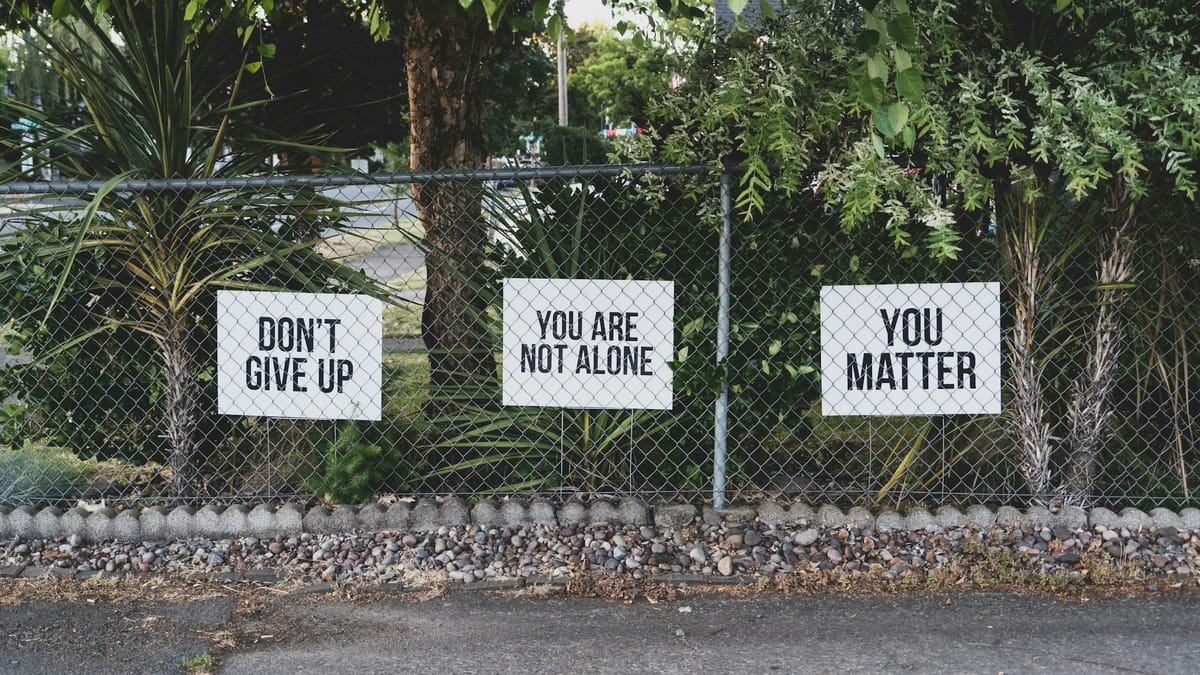Beyond the Binary: A Multidimensional Perspective on Mental Health and Well-being
Have you ever stopped to truly assess your mental well-being, beyond just asking if you're "okay? Mental health is determined by a complex interplay of biological, psychological, social, and environmental influences. Understanding these interconnected elements is crucial for effective prevention.

Have you ever stopped to truly assess your mental well-being, beyond just asking if you're "okay?
Mental health is more than just the absence of illness; it's about taking care of your emotional, psychological, and social well-being for a richer, more fulfilling life.
Mental health is often discussed as a binary – either you have it, or you don't. However, a truly comprehensive understanding recognizes it as a multifaceted and dynamic spectrum of well-being. It is a critical component of our overall health, influencing how we think, feel, act, and relate to the world around us.
Understanding and prioritizing mental well-being is essential not only for individual development but also for building a healthier, more resilient, and economically stable society. This understanding is increasingly acknowledged in clinical practice and research, making a comprehensive approach more important than ever.
This blog post will explore mental health from a multidimensional perspective, examining it beyond the simple presence or absence of a mental illness. We'll delve into the various dimensions of mental well-being, including emotional, psychological, and social aspects, and highlight the importance of each. We will also examine epidemiological data that shows the prevalence of mental health issues worldwide and the burden that they place on healthcare systems and society, with an emphasis on early detection and intervention to improve outcomes.
Furthermore, we will discuss the complex interplay of biological, psychological, social, and environmental factors that influence mental health. Finally, we will touch upon one of the most important topics when overcoming mental health issues: the challenges and opportunities in mental health, including stigma reduction, access to care, emerging research, and policy improvements, emphasizing the necessity for continued research, education, and advocacy to improve global mental health outcomes and encourage healthcare professionals to prioritize mental health in their practice and communities.
Defining Mental Health: Beyond Absence of Illness
Mental health, in its broadest sense, transcends the mere absence of mental illness; it represents a state of complete emotional, psychological, and social well-being. It's a positive condition that enables individuals to cope with the normal stresses of life, work productively, and contribute to their communities.
Understanding this holistic definition is crucial, as it shifts the focus from solely treating mental disorders to actively promoting mental wellness. But how do we actively promote this wellness? What concrete steps can we take? While the absence of conditions like depression, anxiety, or schizophrenia is certainly desirable, true mental health encompasses a much richer and more proactive set of attributes.
It's essential to distinguish between mental health and mental illness. Mental illness refers to diagnosed conditions that significantly impair cognitive, emotional, or behavioral functioning, impacting a person's ability to perform daily tasks and maintain relationships. Mental health, on the other hand, is a continuum, with individuals fluctuating between periods of optimal well-being, manageable stress, and, at times, vulnerability to mental distress. Good mental health acts as a buffer, providing the resilience needed to deal with life's inevitable challenges preventing diagnosable disorders.
The key dimensions of mental health are intertwined and mutually reinforcing. Emotional well-being involves the ability to understand and manage one's emotions effectively, fostering a sense of self-esteem, optimism, and overall life satisfaction. Stress management skills are also crucial, allowing individuals to navigate challenging situations without becoming overwhelmed. Psychological well-being centers on coping mechanisms that enable one to face life's challenges with resilience, adapt to change, and cultivate a sense of purpose and meaning.
Finally, social well-being emphasizes the importance of healthy relationships, strong social support networks, and a sense of belonging within a community. These elements provide a sense of connection and security, fostering a feeling of significance and value that significantly contributes to overall mental wellness. All of these dimensions of mental health, working in harmony, and all equally important, allow people to thrive and live fulfilling lives.
The global prevalence of mental health conditions is a stark reminder of the urgent need for comprehensive and proactive approaches to mental health care. Statistics reveal that hundreds of millions of people worldwide experience mental disorders, with depression and anxiety being among the most common. These conditions impose a substantial burden on healthcare systems, leading to increased medical costs, reduced productivity, and significant societal challenges.
Early detection and intervention are crucial in mitigating the long-term impact of mental health disorders. Implementing screening programs, promoting mental health literacy, and providing timely access to appropriate care can significantly improve outcomes and reduce the personal and economic costs associated with mental illness.
What are the Factors Influencing Mental Health? The Vital Role of Professionals
Mental health is not determined by a single factor, but rather a complex interplay of biological, psychological, social, and environmental influences. Understanding these interconnected elements is crucial for effective prevention, intervention, and treatment strategies. Your genes are not your destiny, and there's still much you can do to positively influence your mental well-being.
Psychological factors, including life stressors, trauma, and coping mechanisms, also play a significant role. Adverse childhood experiences, significant life events, and chronic stress can overwhelm an individual's ability to cope, leading to the development of mental health problems. Healthy coping mechanisms, such as mindfulness, exercise, and strong social connections, can buffer against the negative impact of stress and trauma.
Social determinants, such as socioeconomic status, family dynamics, and access to mental health care, exert a profound influence on mental well-being. Poverty, discrimination, and lack of educational opportunities can create chronic stress and limit access to resources that promote mental health. Dysfunctional family dynamics, such as abuse, neglect, or parental mental illness, can also significantly impact a child's development and increase their vulnerability to mental health problems. Limited access to mental health care, particularly in underserved communities, further exacerbates these challenges.
Environmental factors, like the work environment, social isolation, and community support, also contribute to an individual's mental state. A toxic work environment characterized by high stress, lack of autonomy, and poor social support can negatively impact mental health. Social isolation, particularly among older adults and individuals with disabilities, can lead to feelings of loneliness, depression, and anxiety. In contrast, supportive communities that offer social connection, resources, and opportunities for engagement can promote mental well-being and resilience.
Within this complex web of factors, healthcare professionals play a vital role in safeguarding mental health and preventing catastrophic outcomes. Integrated care models, where mental health screening is incorporated into primary care settings, allow for early detection and intervention. By encouraging open dialogue with patients and creating a supportive care environment, professionals can foster trust and encourage individuals to seek help when needed. Advances in pharmacotherapy, psychotherapy, and behavioral interventions provide a range of treatment options tailored to individual needs.
Moreover, ongoing research informs clinical practice and shapes mental health policy, leading to more effective and evidence-based interventions. Healthcare professionals are often the first line of defense, equipped with the knowledge and skills to identify warning signs, provide immediate support, and connect individuals with appropriate resources, potentially averting crises such as suicide or severe mental health episodes. Their role extends beyond treatment to prevention, education, and advocacy, promoting mental well-being within their practices and communities.
Overcoming Barriers: Addressing Stigma and Expanding Access to Mental Health Care
One of the most significant challenges in mental health is the pervasive stigma surrounding mental illness. This stigma, often rooted in misinformation and fear, prevents individuals from seeking help and perpetuates a culture of silence and shame. Addressing stigma requires a multifaceted approach that includes raising awareness, promoting education, and fostering open dialogue about mental health.
Public health campaigns can play a crucial role in dispelling myths and misconceptions, while personal stories of recovery can humanize the experience of mental illness and inspire hope. Encouraging respectful language and media portrayals can further reduce stigma and create a more supportive environment for individuals seeking help. How can we each become active participants in challenging the stigmas surrounding mental health in our daily interactions?
Intertwined with the challenge of stigma is the issue of access to care. Significant barriers prevent many individuals from receiving the mental health services they need, including healthcare disparities, a shortage of mental health professionals, and the high cost of treatment. Healthcare disparities disproportionately affect marginalized communities, including racial and ethnic minorities, LGBTQ+ individuals, and those living in rural areas.
These groups often face systemic barriers to care, such as discrimination, language barriers, and lack of culturally competent services. Addressing these disparities requires targeted interventions that promote equity and ensure that all individuals have access to quality mental health care, regardless of their background or location. Telehealth solutions have arisen in recent years, but is that enough?
The shortage of mental health professionals, particularly in rural and underserved areas, further limits access to care. Expanding the mental health workforce requires increased investment in training programs, incentives for professionals to practice in underserved areas, and innovative models of care delivery, such as collaborative care and telehealth.
The cost of mental health treatment is also a major barrier for many individuals, particularly those without insurance or with high deductibles. Expanding insurance coverage for mental health services, increasing public funding for mental health programs, and providing financial assistance to low-income individuals can help make care more affordable and accessible. What steps can be taken at a local level to advocate for increased accessibility and affordability of mental health services?
Ultimately, overcoming the challenges of stigma and access to care requires a collaborative, multidisciplinary approach that involves individuals, families, communities, healthcare professionals, policymakers, and researchers. Continued research is essential for developing new treatments and interventions, while policy and public health initiatives are needed to promote prevention, early detection, and access to care. By working together, we can create a society that values mental health, supports individuals in need, and ensures that everyone has the opportunity to thrive. What role do you see yourself playing in fostering a more supportive and equitable mental health landscape?
How Important Healing Strategies and Professionals are in Overcoming Depression: The Story of The Depression Project Co-Founder Danny Baker
Danny Baker, co-founder of The Depression Project, experienced a severe depressive episode starting in 2008, leading to alcoholism, drug abuse, and multiple hospitalizations. A key trigger was his extreme perfectionism. He felt worthless and suicidal if he didn't achieve his goals, like getting 85% in a university exam instead of 79%. For two years, Danny didn't address this underlying issue, mistakenly believing that achieving all his goals would prevent depression.
After seeking help from a psychologist, Danny realized his self-worth was entirely tied to his accomplishments. His psychologist emphasized that being human means making mistakes and not always achieving goals. Danny needed to love himself regardless of his achievements. Danny began to create a list with the psychologist of reasons to love himself that had nothing to do with achieving his goals: kindness, compassion, honesty, and humility.
Focusing on these qualities, Danny started to see himself as a good person, irrespective of his accomplishments. The next time he failed an exam, he felt disappointment but not the usual self-hatred or suicidal thoughts. Danny had finally addressed a significant underlying cause of his depression: feelings of worthlessness due to perfectionism. This marked a turning point, as Danny continued implementing strategies to overcome depression's other causes, eventually achieving lasting recovery (Baker, 2023: 63).
Your Top Questions Answered
1. What exactly is mental health?
Mental health is your overall emotional, psychological, and social well-being. It affects how you think, feel, and act, and helps determine how you handle stress, relate to others, and make choices. It's a positive state of well-being, not just the absence of mental illness.
2. What are the signs of poor mental health?
Signs can vary, but common indicators include persistent sadness, excessive worry or fear, changes in sleep or appetite, difficulty concentrating, withdrawal from social activities, unexplained physical ailments, and feelings of hopelessness or worthlessness. If you're experiencing these, seeking professional help is essential.
3. How can I improve my mental health?
Prioritize self-care activities like exercise, healthy eating, and sufficient sleep. Practice mindfulness and stress-reduction techniques. Nurture strong social connections. Set realistic goals and celebrate small achievements. Seek professional guidance if needed.
4. What's the difference between stress and anxiety?
Stress is a normal response to a specific demand or challenge, usually short-term. Anxiety is a more persistent and excessive worry that can occur even without a clear trigger, often interfering with daily life.
5. What should I do if I think a loved one has a mental health problem?
Express your concern in a non-judgmental way. Listen actively and offer support. Encourage them to seek professional help and offer to assist them in finding resources. Be patient and understanding throughout the process.
6. Is it okay to talk about my mental health?
Absolutely! Talking about mental health is a sign of strength and can help break down stigma. Sharing your experiences can encourage others to seek help and create a more supportive community.
7. Where can I find help for my mental health?
Many resources are available, including primary care physicians, therapists, psychiatrists, psychologists, support groups, and mental health organizations. Online directories and helplines can also provide valuable assistance.
8. How can I support someone with a mental illness?
Be patient, understanding, and supportive. Listen without judgment and validate their feelings. Educate yourself about their condition and offer practical assistance. Encourage them to adhere to their treatment plan and celebrate their progress.
9. Can mental health issues be prevented?
While not always preventable, you can reduce your risk by practicing self-care, building resilience, and addressing risk factors early. Promoting mental health awareness and creating supportive environments can also help prevent the onset of mental health problems.
10. How does social media affect mental health?
Social media can have both positive and negative effects. It can provide connection and support, but also contribute to feelings of inadequacy, social comparison, and cyberbullying. Be mindful of your social media usage and prioritize real-life connections.
Key Takeaways
- Mental health is more than just the absence of illness: It encompasses emotional, psychological, and social well-being, requiring proactive cultivation.
- Distinguish between mental health and mental illness: Mental health is a continuum, not a binary, and focuses on promoting wellness, not just treating disorders.
- Emotional well-being matters: Cultivate self-esteem and develop effective stress management techniques to enhance your emotional resilience.
- Build psychological resilience: Develop healthy coping mechanisms to navigate life's challenges and foster a sense of purpose.
- Nurture social connections: Strong relationships and social support networks are vital for mental well-being and a sense of belonging.
- Address the factors affecting mental health: Understand how biological, psychological, social, and environmental influences impact your mental state and seek support accordingly.
- Break the stigma: Challenge misconceptions and foster open dialogue about mental health to create a more supportive environment.
- Advocate for access to care: Support policies and initiatives that improve access to affordable and culturally competent mental health services.
- Embrace innovative approaches: Explore the potential of digital mental health tools and emerging research to enhance your mental well-being.
- Healthcare professionals are key: They are the first line of defense to prevent mental health problems and provide the necessary support.
References
https://thedepressionproject.com/?srsltid=AfmBOop6YMaBmo24sFjIlk-zVYtQcVg7xrJmyQnlk-VOxW1koohjcKQS
https://www.psychiatry.org/patients-families/stigma-and-discrimination
https://www.who.int/news-room/fact-sheets/detail/mental-health-strengthening-our-response
https://www.cdc.gov/aces/about/index.html
https://secure.cihi.ca/free_products/summary_mh_mar0309_e.pdf
https://www.researchgate.net/publication/281563429_Defining_and_measuring_mental_health_and_wellbeing
https://www.nimh.nih.gov/health/statistics
https://pubmed.ncbi.nlm.nih.gov/38214615/
https://www.apa.org/news/press/releases/2023/12/mental-health-access-challenges
https://health.ec.europa.eu/non-communicable-diseases/mental-health_en#:~:text=Mental%20health%20situation%20in%20Europe,-The%202023%20edition&text=The%20need%20for%20action%20was,in%20the%20past%20twelve%20months.
https://www.oecd.org/en/topics/mental-health.html
This article was written by Ariadna Paniagua, an experienced writer and editor for several institutions, papers, and websites.




